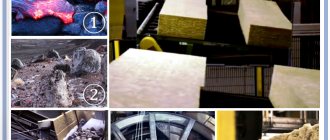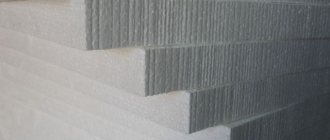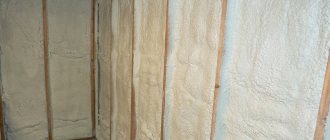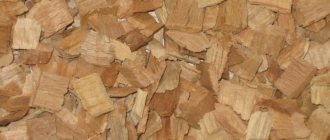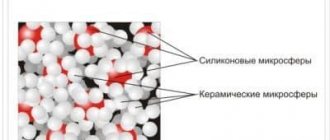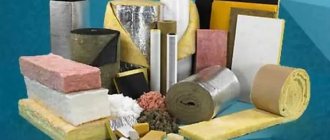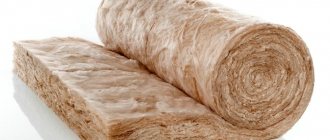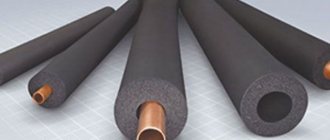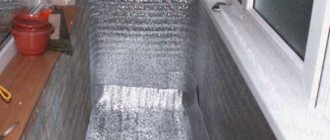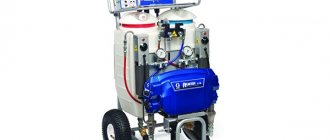Today we will tell you about bulk insulation, which is available in eight different types. The variety is simply impressive, as they are made from paper, stone, resin, polymers and even clay. Each material has its own strengths and weaknesses, although there are also those that there is nothing to praise for, even if one would like to. All bulk insulation can be installed using two methods: manually or using a compressor. Such materials are good because they fill all the cracks and voids. And negative qualities include shrinkage, which is inherent in all insulation materials from this cohort.
Expanded polystyrene crumbs
Styrofoam crumbs.
The first bulk insulation we will consider is polystyrene foam. If you look closely at a sheet of polystyrene foam, you can see that it consists of many balls. These component parts may not be fastened together, and their density decreases. If you take a sheet of polystyrene foam and loosen it into individual balls, they will take up much more space. Naturally, as the density decreases, the material’s resistance to heat transfer decreases somewhat, so unless absolutely necessary, it is better to use sheets. Also read: “Technological features of insulating facades with foam plastic.”
Bulk insulation for walls made from foam spheres is used only when it is necessary to fill the cavities of already built structures. The crumbs are simply blown out using a special machine, trying to achieve maximum density. The disadvantage of crumbs is that the insulation can shrink. In addition, the material:
- burns;
- emits toxic smoke;
- Rodents feel great in it.
This bulk wall insulation is transported in plastic bags. Can be used to insulate floors, ceilings, and pitched roofs.
How does a chimney for a solid fuel boiler differ from its counterpart for a gas heater with a sealed combustion chamber?
You will find everything about how to choose a chimney for a gas boiler here.
Backfilling methods
The process of filling any insulation is the same: the material is poured into the cavity and compacted. It is recommended that the issue of insulation be addressed immediately when designing a house. If there are no internal cavities for filling in insulation, layers are made using PVC panels or plasterboard.
A good option is when the insulation is poured between facing and ordinary bricks, between internal and external masonry. There may be ribs inside so that it is well distributed. Thanks to loose thermal insulation, the walls do not need to be made thick, which saves costs. There are ready-made concrete products on sale - slabs, inside of which there are already cavities filled with expanded clay; they retain heat 50% better than ordinary ones.
Options
For floors, these methods of insulation with bulk components are used. The first option is fill-in (or loose) insulation on the joists. Joists are made on the floor on posts, skull blocks are nailed, then flooring is made of boards. A vapor barrier is placed on the flooring and expanded clay is poured. Further, if necessary, the next layer of thermal insulation, on it - screed, rough wood flooring.
The second option is an embankment on top of a concrete slab. An option for low-quality housing - Khrushchev, for example - when it is possible to raise the floor level. The floor covering is removed, waterproofing is laid, expanded clay is poured onto it in a layer of 5 - 10 cm. Then you can put a mesh for reinforcement, and a rough screed is made on it - the basis of the finishing floor covering. A vapor barrier is laid on top of the expanded clay cushion, and another layer of insulation is placed on top of it.
Loose penoizol
Penoizol flakes have a random shape.
In appearance, penoizol looks like foam chips, but if you look more closely, the difference is obvious. Despite the visual similarity, these are two completely different materials. Penoizol is more reminiscent of snow flakes, it does not have an ideal ball shape, this material is softer. Penoizol is used as fill-in insulation for walls and horizontal ceilings. In addition, it is also available in sheets, but is mainly used in liquid form. Unlike polystyrene foam, penoizol:
- does not burn;
- does not smoke;
- allows moisture to pass through, but does not absorb it.
The thermal conductivity characteristics of both materials are almost equal.
Penoizol backfill insulation for walls is made from resin. The quality of the material primarily depends on the quality of the resin used for production.
First, the liquid substance is poured into blocks, about a meter by meter. Then the blocks are cut into sheets, and only then the sheets are crumbled. Installation is carried out using a blowing machine or manually. When working, you need to control the degree of density of the material.
Foam glass in granules
Fractions of foam glass come in different sizes, up to crushed stone.
It is made from broken glass, which is crushed into smallest fractions, melted and mixed with coal. As a result, carbon dioxide begins to escape from the material, which forms air spheres in the structure of the foam glass. This is a very expensive material; it is used in industrial facilities or in the construction of high-rise buildings. It is used extremely rarely in private construction, since not everyone can afford such a cost. They are used as bulk insulation for ceilings, floors and walls, and in the form of slabs or blocks. Bulk comes in different fractions, based on this, it looks like:
- granules;
- crushed stone
Bulk foam glass insulation has the following characteristics:
- does not absorb water;
- does not burn;
- thermal conductivity 0.04–0.08 W/m*C;
- does not allow steam to pass through;
- high compressive strength 4 MPa;
- bending strength is even more than 0.6 MPa;
- operating temperature range from -250 to +500 degrees.
The peculiarity of using bulk insulation for floors is that foam glass can be part of the cement mortars with which the screed is poured. The same is true when pouring foundations; instead of ordinary crushed stone, you can use foam glass.
Why is it necessary to include filters for gas boilers in the heater piping? Wiring diagram and installation methods.
Interested in installing a safety group for heating: video instructions here.
Insulation of walls and ceilings
To make the house warm and comfortable, it is necessary to insulate the external walls. For this purpose, foam glass, a granular environmentally friendly material obtained from raw fractions by foaming, can be used. This wall insulation is chemically resistant and can form the basis of heat-insulating plaster. Foam glass is ideal for insulating basement walls and foundations, since it is not afraid of groundwater.
A granule of foamed polymers is the basis of penoplex, a lightweight and moisture-resistant thermal insulation material. This heat insulator does not have a very wide operating temperature range, so it is not recommended to use it for insulating baths. Penoplex can be quite easily filled with frame walls. The granules fill the smallest voids.
Mineral wool for wall insulation can be used not only in the form of conventional slabs or rolls, but also in the form of granules larger than 10 mm in size. Such bulk insulation is vapor-permeable and fire-resistant, and is not afraid of high temperatures. In addition to thermal insulation properties, granulated mineral wool has good sound insulation properties. When laying mineral wool, it is necessary to provide protection for the skin and respiratory tract.
Mineral wool for wall insulation can be used not only in the form of conventional slabs or rolls, but also in the form of granules larger than 10 mm in size.
To preserve heat in rooms, ceilings are often insulated. Recently, penoizol, which looks like foam chips, has gained popularity. This lightweight, low-density material is characterized by increased biological resistance. Rodents and mold will not grow in such a thermal insulation layer.
When choosing heat-insulating bulk materials, you should pay attention to such characteristics as thermal conductivity, density, moisture absorption, weight and particle size. Most of the bulk insulation can be delivered and installed independently, which will significantly reduce the cost of insulation work, which is especially important for owners of dachas and small country houses.
An interesting argument comparing two types of insulation:
Expanded clay
Expanded clay is ugly, but time-tested.
Probably the oldest and most well-known fill-in insulation is expanded clay. Made from clay by firing. Depending on the size of the fractions, it comes in the form of:
- gravel;
- crushed stone;
- sand (dropouts).
It should be noted that expanded clay is much cheaper than its competitors, namely perlite and vermiculite, which we will talk about a little later. The density of the material can vary between 250-800 kg/m. cube The degree of thermal conductivity ranges from 0.10 to 0.18 W/m*C.
Expanded clay practically does not absorb moisture; this process occurs very slowly. But, having filled up with water, he is very reluctant to part with it, which cannot but affect his characteristics.
It is used as bulk insulation for walls, floors, ceilings and roofs. Also read “Using expanded clay for roofing.” It does not enter into any chemical reactions, mold does not grow in it, and mice do not live in it. Since the starting material for manufacturing is clay, expanded clay has all its positive qualities:
- does not harm health;
- does not burn;
- does not contain poisons.
Expanded clay can be mixed with sawdust, but the insulation layer should be slightly larger, since wood has a slightly lower resistance to heat transfer.
Recommendations
For backfilling there are the following recommendations. Firstly, bulk material settles over time, so it needs to be compacted well. It is advisable to use boiler slag and expanded clay in regions where winter temperatures do not drop below -20°C. Insulation of pitched roofs with expanded clay and similar compounds is carried out from the outside, after laying the vapor barrier. Transverse stops are installed along the slope between the rafters - they evenly distribute the insulation.
After laying it on the floor or in the basement, it is well compacted to prevent shrinkage and deformation of the finish. The only problem is moisture ingress; bulk insulation materials are quite hygroscopic. In baths and saunas and, indeed, everywhere, the insulation layer must have high-quality hydro- and vapor barrier. It is necessary to ensure that there are no cracks in the finishing and that bulk material does not spill through them. It is also worth remembering that expanded clay is quite heavy. It is necessary to ensure that its mass does not push apart too weak partitions or walls.
Loose thermal insulation ecowool
Ecowool was developed as part of a waste recycling program.
This type of insulation was developed in Europe as part of a recycling program. That is, the main goal is to usefully recycle waste. It is made exclusively from newspapers; no more than 10% cardboard is allowed. To prevent ecowool from burning, microorganisms from growing in it, and mice not gnawing on it, borax and boric acid are added to the detailed newsprint.
It is used as bulk insulation for floors and walls, installation is carried out using dry and wet methods. The density when blown by machine is 65 kg/m in the wall. cube, on floors 45 kg/m. cube, density for manual laying - up to 90 kg/m. cube Thanks to fire retardants, the material does not burn, but smolders successfully.
The service life of ecowool produced in the Omsk and Tomsk regions is 10–12 years. Western manufacturers claim that the material will last 50 years. But they give such forecasts based on the climatic conditions of their region, where temperature differences are smaller and, accordingly, less moisture settles in the insulation (due to the dew point). For Russia, with its cold and humidity, these forecasts are unlikely to come true.
The thermal conductivity of ecowool is 0.037–0.042 W/m*C. It easily absorbs moisture and releases it just as easily.
When wet, it becomes heavier, which leads to shrinkage, which is inevitable. In fact, ecowool has nothing to do with environmental friendliness. It is simply stuffed with chemicals and we do not recommend using it.
Features of the material
There are several types of bulk material for insulation. Each of them has its own properties. List of bulk insulation materials:
- expanded clay;
- polystyrene foam in granules;
- foam concrete crumbs;
- ecowool;
- sawdust and sand;
- boiler slag;
- vermiculite
Expanded clay
The usual form of this material is round or oval granules. Granules or other shaped material are porous and very light (some types can float on the surface of the water). Expanded clay is formed by firing light alloy clay. It is absolutely non-flammable, safe, and environmentally friendly in its composition.
The material can be in three forms:
- sand with grain size from 0.14 to 5 mm. It is used as a filler for lightweight concrete and for floor insulation;
- Expanded expanded clay crushed stone is granules with a fraction of 5–40 mm. The best option for thermal insulation of foundations and floors of residential premises;
- expanded clay gravel. Round granules 5–40 mm with a fused surface, absolutely resistant to fire. They have closed pores inside, which gives them excellent frost resistance. This gravel is recommended for insulating attic floors: the material is lightweight and has low thermal conductivity.
The labeling of a material must include the size of its fraction:
- 5–10 mm – floors and roofs;
- 10–20 mm – baths and saunas, able to maintain temperature and humidity in the room for some time;
- more than 20 mm - for foundations and basements.
Expanded polystyrene granules
This is the most controversial bulk material. It is a very light, airy white granule. It is used as backfill for insulating roofs and walls; it is also used as an additive in mixtures for insulating concrete.
The disadvantages are toxicity and flammability, but its properties have not yet been fully studied. Instead, it is recommended to use granulated foam glass. Expanded polystyrene is cheap and convenient for insulation using the well-laying method.
Vermiculite
This is a mica-based layered material. No chemical additives or impurities are used in the manufacturing process. It is an excellent option for insulating loggias and rooms. Used as an energy-saving cladding for housing inside and outside. For floors and walls, a layer of at least 10 cm is recommended, for the roof - at least 5 cm. Backfilling with this material 5 cm thick reduces heat loss by 75%, 10 cm - 92%.
- high breathability of insulation - the material is porous - which allows the walls to “breathe”, ideal for natural circulation, air renewal and ensuring a microclimate in the room;
- environmentally friendly, without toxic substances;
- non-flammable, fire-resistant, belongs to the G1 flammability group;
- fungi, mold, rodents, insects are not afraid of such isolation;
- special skills or experience, special tools are not needed to fill it. The layer of material is simply poured back and compacted. No additional fasteners are needed;
- service life - more than 50 years.
For walls, a vermiculite backfill thickness of 10 cm is sufficient, for attics, roofs, and interfloor ceilings – 5 cm. When laying, it is advisable to use a vapor barrier film - this will additionally protect the insulation from moisture.
Sawdust and sand
These are traditional heat preservation materials that are used in attics and basements and have been used for centuries. Disadvantages: they are poorly insulated from moisture, pests can grow in them. Sawdust is flammable and susceptible to mold and mildew. It is still recommended to use more modern materials.
For insulation, they use not ordinary sand, but perlite. It is light weight, less hygroscopic, and its characteristics resemble mineral wool. Due to its low bulk density, it does not create a load on the walls and does not burst them.
Ecowool or cellulose
The components of this insulation are ecowool (7%), shredded paper (81%), antiseptics (12%) and fire retardants (7%). The material is non-flammable and does not rot thanks to special impregnations. It has been used in the world for more than 80 years; it has been known in the CIS for the last decade.
This material uses boric acid as an antiseptic and borax as a fire retardant. These substances are environmentally friendly.
The material is quite practical: the fibers fill small voids well, so it is recommended for complex structures.
Bulk perlite insulation
Perlite is always white.
Perlite is a volcanic ore (acidic glass). For insulation, construction perlite is used, the fraction of which varies from 0.16 to 1.25 mm. After ore is mined, it is crushed and heated to 1 thousand degrees. It is important that the heating is carried out sharply, and the water that is in the structure of the rock begins to evaporate. As a result of this process, perlite swells and reaches a porosity of 70–90%.
Material characteristics:
- thermal conductivity 0.04–0.05 W/m*K;
- does not burn;
- does not absorb moisture;
- allows steam to pass through;
- chemically inert.
The density of insulation in the wall varies from 60 to 100 kg/m. cube Membranes cannot be used during installation, as they quickly become clogged during operation. For installation on pitched roofs, perlite treated with bitumen is used. After a solvent is added to bituminized perlite, it becomes sticky, and after it hardens, it forms a single insulating layer of any shape.
Vermiculite backfill insulation
Vermiculite has become very popular recently.
Loose thermal insulation vermiculite is made from mica - an ore that is mined in quarries. The ore is broken into small fractions, which are subsequently intensively heated to 700 degrees and due to the evaporation of moisture, swelling occurs; naturally, the fractions increase in volume. If you gradually heat the mica fractions, the moisture will slowly evaporate and swelling will not occur.
The service life of the material is unlimited, because there are no adhesive impurities in it, there is simply nothing there to spoil. Material characteristics:
- thermal conductivity 0.048-0.06 W/m*K;
- density 65-150 kg/m. cube;
- does not burn;
- non-toxic;
- allows steam to pass through;
- when moistened by 15%, it does not lose its thermal insulation properties.
Vermiculite transports and distributes liquids well. This means that even with intensive, deliberate moistening of a separate area, perlite will evenly distribute moisture over all its areas, and then completely remove it outside. This property allows you to minimize the consequences of getting the insulation wet. Vermiculite costs almost the same as ecowool (about 4,500 rubles per cubic meter). It can be mixed with sawdust in a 50/50 ratio.
Wood sawdust
The thermal conductivity of sawdust is 0.07–0.08 W/m*C. Sawdust is rarely used as an independent insulation material, as it is prone to absorbing moisture and further rotting. Therefore, they are mixed with other materials:
- clay;
- expanded clay;
- perlite;
- vermiculite
The ability of these materials to remove moisture prevents sawdust from being blocked even when laid in a thick layer. By the way, you can only use small sawdust, which is obtained when processing wood on modern machines with high speeds.
Having examined all types of bulk insulation, we can conclude that heat insulators made from rocks and clay have proven themselves to be the best. In terms of price/practicality/heat transfer resistance, the best option is penoizol. An outsider in our rating, ecowool is poison in its purest form, nothing less.
Comparing different roof insulation materials
Is it convenient to use bulk insulation?
Since we are talking in this publication about insulating roof slopes from the inside, then we will “put out of the brackets” bulk thermal insulation materials, such as expanded clay, perlite, vermiculite. They are convenient for insulating the attic floor, that is, the horizontal plane. They are also used for thermal insulation of wall structures made according to the principle of well masonry. There are technologies for their use on pitched roofs with a relatively small slope, however, this approach is not particularly widespread due to the rather complex design of the “roofing pie”. In addition, the same expanded clay is significantly inferior to other insulating materials in terms of its thermal insulation characteristics, which means that a thick layer will have to be provided, which is quite problematic on a pitched roof.
There is a technology for insulating roof slopes with bulk thermal insulation materials, but it is not particularly widespread
Vermiculite in terms of its thermal conductivity is closer to modern insulating materials, but its cost is very high, and its use in this case is unlikely to be justified.
Let us immediately note that there are supporters of the use of available natural materials. For example, for a long time, dry leaves, pine needles, sawdust, etc. were used to insulate the floors of houses. Again, what is good for horizontal surfaces is not entirely suitable for a pitched roof.
Bulk insulation is an excellent option for thermal insulation of floors
Bulk thermal insulation materials are widely used for a wide variety of insulation work in houses and apartments. Excellent results are shown by floors insulated with expanded clay . There are several interesting technologies for using sawdust as insulation . All these issues are given due attention on the pages of our portal. Pay attention to vermiculite insulation - some novice builders do not even know about the existence of such a material.
But still, in the vast majority of cases, other thermal insulation materials are used to insulate roof slopes. They can be divided into three groups:
- rigid insulation, usually based on polystyrene foam.
- fibrous insulation in the form of slabs or mats - mineral wool.
— sprayed thermal insulation materials, representatives of which include polyurethane foam and ecowool.
Styrofoam
Polystyrene based rigid insulation
Such insulation materials include the well-known white polystyrene foam and extruded polystyrene foam. Despite the fact that their basic component, the raw material for production, is the same organic compound, the difference in manufacturing technology determines serious differences in the physical and operational characteristics of the resulting materials.
Styrofoam
This material is obtained using a fairly simple technology that does not require highly complex equipment. At the first stage, raw material granules go through the foaming stage - under the action of hot steam they sharply increase in size (20-50 times), turning into gas-filled balls in a polystyrene shell. These balls undergo drying and stabilization procedures, and then in special molds, under a certain temperature and humidity conditions and under the required pressure, are sintered into blocks of a given size. Subsequently, after final “ripening”, the blocks are cut into sheets of standard sizes and thicknesses.
Polystyrene foam is air-filled polystyrene balls connected to each other on the surface.
As a result, the finished polystyrene foam is a kind of conglomerate of balls “glued” together. The proportion of air in the foam structure is over 90%, which, in principle, determines its high thermal insulation qualities.
The production of polystyrene foam does not require excessive costs, therefore the material can be classified as the most affordable of all other insulation materials.
It would seem - what more could you want? The material provides good thermal insulation, is lightweight, inexpensive, very easy to process, and is produced in blocks of precise “geometry,” meaning it will be easy to work with. However, not everything is as wonderful as it might seem at first glance.
- Let's start with thermal insulation qualities. They are actually quite good - the thermal conductivity coefficient is usually around 0.038 W/m×C°. But it should be correctly understood that this value will only be valid for ideal operating conditions. The trouble is that although foam plastic is not considered a particularly hygroscopic material - the input does not penetrate into the balls, the spaces between them can absorb moisture, and in sufficiently large quantities. It happens that low-quality foam absorbs moisture, which is almost three times its weight! Naturally, in this situation, the thermal insulation characteristics of the material are sharply reduced.
- The second alarming point is a direct consequence of the first. Moisture that penetrates into the material due to temperature changes can cause cracks or even coloring of the foam. In addition, studies have shown that this material cannot in any way be classified as particularly durable - the mentioned “water corrosion” of foam plastic leads to the formation of soft cavities, through “cold bridges” through cracks, and as a result, cases have been recorded when such important insulating qualities are no longer after 5 ÷ 7 years of operation they decrease several times!
Disintegration of low-quality polystyrene foam - the connections between individual granules are almost completely lost
- The third important drawback is the “inherent” chemical instability of polystyrene. The fact is that it belongs to the group of equilibrium polymers, that is, under certain conditions, the process of depolymerization - decomposition into components - can begin. Not only does the foam become loose and fall apart into individual balls, but this is accompanied by the release of free styrene into the air, an extremely dangerous toxic chemical compound for humans that can cause or intensify various diseases.
The higher the temperature and humidity of the material, the more active the decomposition process is. And in the summer under-roof space there will be more than enough of both!
An eloquent sight - the facade of a house insulated with polystyrene foam is on fire
- Perhaps the most important disadvantage of polystyrene foam is its flammability. No matter how manufacturers describe the safety of the material, almost all polystyrene foam of this type belongs to group G4, the lowest. Moreover, when ignited, the foam melts and can become a distributor of “liquid flame.” And the worst thing is that during thermal oxidation, extremely toxic products are released in very large volumes, which can cause almost instantaneous poisoning or chemical burns of the respiratory system. Unfortunately, the statistics of fire tragedies indicate that people caught in a polystyrene fire zone have minimal chances of survival.
The market for unpressed polystyrene foam (foam) is literally teeming with low-quality materials
- And finally, purely “everyday” considerations. The fact is that the ease of production of polystyrene foam has become the reason that it is produced everywhere, often in semi-handicraft conditions. Naturally, in pursuit of quick profits, the owners of these “factories” often violate the established technology, ignore some mandatory stages (drying, ripening, etc.), and as a result, the output material does not comply not only with GOST standards, but even more “ liberal" TU. The result is increased fragility, chemical instability, uneven density, persistent unpleasant odor, etc. Moreover, these shortcomings may be subtle at first, but appear very quickly later, during operation.
By the way, in many countries such expanded polystyrene is legally prohibited for use in residential construction. For the reasons stated above, it was completely abandoned in the production of cars, buses, and railway cars, switching to the use of much safer polyurethane foam. And you probably need to be an extremely “risky” home owner to use it for roof insulation. There are many other, much more effective and safer options.
Extruded polystyrene foam
The production technology of this material is radically different. A melt is prepared from granular raw materials, to which special additives are added that increase the chemical stability of the polymer and give it greater resistance to fire. Special additives provide foaming of the melt, and in this state it is forced through the molding nozzles of the extrusion line. When solidified, a structure is obtained with gas-filled cells of a completely buried type, isolated from each other, and without any gaps between them where moisture can penetrate. Thus, the hygroscopicity of the material tends to zero.
Mineral wool
Homogeneous cellular gas-filled structure of extruded polystyrene foam
The material is obtained with high gas saturation, clearly uniform density throughout its entire thickness, and its strength properties are much superior to those of foam plastic. The heat transfer resistance characteristics also look better. The blocks have clear geometric dimensions, and most types of high-quality extruded polystyrene foam are also equipped with lamellas for seamless connection in one plane.
The introduction of special additives into the composition of extruded polystyrene foam significantly increases the fire safety of the material. Many types are assigned category G1, that is, the polymer practically does not ignite even when exposed to open fire, quickly self-extinguishes and does not spread flame. However, in the event of a fire, during the thermal decomposition of such expanded polystyrene, toxic substances will be released to a no less extent than those of polystyrene foam, and this should be kept in mind.
Another advantage of extruded polystyrene foam is that the rather complex technology of its production significantly reduces the risk of running into semi-handicraft products. This market segment has its own “heavyweights”, and one of the brands that has earned an unconditional reputation for quality is Penoplex. The universal-use slabs “Penopdex-Kofmort” are also perfect for roof slopes.
Insulation boards of the universal type "Penoplakas-Comfort"
To compare the parameters of polystyrene foam and extruded polystyrene foam, their main physical and operational characteristics are summarized in the table:
| Parameters of thermal insulation materials | Foam plastic (using the example of PSB-S-50) | Plates of extruded polystyrene foam (using the example of Penoplex-Comfort) |
| Illustration | ||
| Thermal conductivity (W/m oC) | 0,039 ÷ 0,050 | 0,028 ÷ 0,034 |
| Vapor permeability (mg/m×h×Pa) | — | 0,017 |
| Water absorption over 24 hours in % of volume | 0.6 | 0.4 |
| Ultimate strength at static bending MPa (kg/cm²) | 0,07 ÷ 0,20 | 0,4 ÷ 0,7 |
| Compressive strength 10% linear deformation, not less than MPa (kgf/cm²) | 0,15 ÷ 0,2 (1,5÷2) | 0,25 ÷ 0,3 (2.5÷3) |
| Density (kg/m³) | 35 ÷50 | 28 ÷ 35 |
| Operating temperatures | -50 to +75 | |
| Fire resistance category | G4 (flammable) | G1 (non-flammable, self-extinguishing) |
| Standard panel sizes, mm: | ||
| - lenght and width | 1000 ×1000 | 600 ×1200 |
| - thickness | from 20 to 200 | 20; 30; 40; 50; 60; 80; 100 |
The highlights of any polystyrene foam can be easily cut, and when insulating the roof, they are adjusted to the distance between the rafters. However, due to the lack of proper plasticity and elasticity of the material, it is impossible to do without cracks and gaps, and they will have to be filled with polyurethane foam.
To get rid of cold bridges, they often resort to two-layer insulation, with the second layer being completely continuous - the rigidity of extruded polystyrene foam makes it possible to do without lathing.
Continuous insulation with a second layer from the attic side
The opposite approach is also practiced - continuous insulation is performed from the outside, thus turning into a kind of continuous sheathing. Since extruded polystyrene foam has extremely low hygroscopicity and vapor permeability, its continuous layer also becomes an effective hydro- and vapor barrier.
Wooden bathhouse, completely “clad in a fur coat” of extruded polystyrene foam
Low vapor permeability of the material can lead to a “thermos” effect inside the attic, therefore, in order to prevent an overly damp atmosphere, effective ventilation of both the attic itself and the under-roof space must be thought out.
Conclusions.
- If you plan to insulate roof slopes with expanded polystyrene, then the choice should still be made in favor of extruded one, despite the fact that this option will be more expensive.
- Do not forget that any polystyrene foam in the event of a fire can pose a mortal threat to people.
- Due to the chemical characteristics of the material, you should not practice insulation with it if there is a living room in the attic - under the influence of elevated temperatures from the roof slopes heated in the sun, the emission of toxic styrene is possible.
- If it is possible to use another, safer material, you should take advantage of it, since the disadvantages of polystyrene for roof insulation still outweigh its advantages.
Mineral wool
Mineral wool insulation materials are extremely popular when carrying out thermal insulation work. All of them have a common feature - they are a thick layer of densely intertwined thin fibers that are drawn from a melt or other mineral component. This weave creates a layer of immobilized air, which becomes an excellent barrier to heat transfer.
Depending on the material used to make the fibers, all mineral wools can be divided into three groups - slag, fiberglass and basalt.
Slag
To produce insulation of this type, waste from metallurgical production is used - blast furnace slag is melted in furnaces, and fibers are formed from them, which are then pressed into mats using a binder. The material often turns out to be somewhat heterogeneous, so slag mats are usually additionally quilted with cords.
Slag wool - it is better to avoid its use in residential construction
Slag wool has few advantages, and only the low cost of the material can be considered significant. But there are so many disadvantages that it is better to immediately refuse to use such insulation in the construction of a residential building
- The initial characteristics of thermal and noise insulation seem to be quite good, but they are quickly lost due to a banal reason - slag wool is extremely hygroscopic, and can be absorbed with moisture literally from the air.
- The chemical composition of the raw material is extremely heterogeneous, therefore slag wool can have a high percentage of residual acidity, which leads to corrosion of the metal structural elements in contact with it.
- Slag wool is afraid of even slight vibration - its fibers are extremely brittle, and the material quickly shrinks, decreases in volume, cakes, losing all its insulating qualities.
- The fragility and thorniness of the fibers make this type of mineral wool extremely inconvenient to work with - special measures are required to protect the skin, eyes and respiratory tract, and there is still a possibility of irritation of the integument.
In a word, it is better not to consider slag wool at all as a possible insulation for the roof.
Glass wool
The material for forming thin fibers in this case is a melt of purified quartz sand or glass production waste (glass waste). A “carpet” is formed from the fibers using binding additives, which, after pressing, is cut into mats or blocks of the required size.
As a rule, glass wool stands out from other insulation materials with a characteristic yellowish tint.
Glass wool blocks or mats usually have a characteristic yellow tint
Glass wool has become extremely widespread due to its low price and good performance.
- It is very plastic, that is, it is compressed to smaller volumes during packaging, expanding before installation, which is convenient for transporting the material.
- It has a low density and, therefore, weight, and will not weigh down the roof truss structure.
- The elasticity of blocks and mats makes it easy to install them between rafters placed at a certain pitch.
Glass wool blocks are very convenient for insulating slopes between rafters
- At the same time, the flexibility of blocks or mats allows the use of glass wool for thermal insulation of complex, curved or broken surfaces, which is sometimes encountered in the construction of original roofs.
However, it also has a number of disadvantages.
- The hygroscopicity of the material is quite high, and, absorbing moisture, glass wool significantly loses its thermal insulation qualities. When using this insulation, reliable vapor and waterproofing is required, conditions are created for the free evaporation of water vapor to prevent the formation of condensation.
- Glass is an amorphous material, so processes of gradual sintering of fibers and increasing the density of glass wool are inevitable. They are not as pronounced as in slag, but still they should not be discounted.
- Fiberglass is quite brittle, and working with such insulation requires the use of protective equipment. In addition, it is necessary to provide a barrier so that the smallest particles of fibers do not penetrate into living spaces - they can cause allergic reactions or exacerbation of respiratory diseases.
- It will not be possible to completely eliminate the emission of binders that contain formaldehyde resins. Taking this into account, you should purchase exclusively reliable material from well-known brands, whose manufacturers carefully control the quality of their products.
For example, many of the significant disadvantages inherent in glass wool have been completely or partially eliminated. A wide range of products is designed for a wide variety of construction areas. But some materials are intended specifically for private housing construction. “URSA GEO” insulating blocks and mats are especially valued. One of the types of insulation even has an eloquent name - “URSA GEO Private House”, and is suitable for almost any area that requires thermal insulation.
They are durable - the manufacturer is not afraid to guarantee a service life of 50 years or more. The material is not subject to shrinkage, chemical or biological decomposition, and formaldehyde emissions are reduced to such a minimum that there are no obstacles to the use of these insulating boards in residential premises.
The name of this high-quality insulation - "URSA GEO Pitched Roof" - speaks for itself
Especially for insulating roof slopes between the rafters, a separate type is produced - “URSA GEO Pitched Roof”, in the production of which the “URSA Spannfilz” technology is used, which literally means “elastic felt”. The mats compress perfectly, are installed between the rafter legs, and, when straightened, provide excellent fixation, which does not even require additional measures to maintain them in place. Naturally, a tight fit also eliminates “cold bridges.”
The table below shows the main indicators of URSA GEO fiberglass insulation, any of which is suitable for insulating a pitched roof
| "M-11" | "A private house" | "Light" | "Pitched Roof" | "Universal plates" | "Framework" | |
| Thermal conductivity coefficient, W/m×°С | ||||||
| λ10 | 0,040 | 0,041 | 0,044 | 0,035 | 0,036 | 0,035 |
| λ25 | 0,044 | 0,044 | 0,047 | 0,038 | 0,039 | 0,038 |
| λA | 0,044 | 0,045 | 0,049 | 0,040 | 0,041 | 0,040 |
| λB | 0,046 | 0,047 | 0,052 | 0,042 | 0,044 | 0,042 |
| Vapor permeability, mg/m×h×Pa | 0,64 | 0,65 | 0,7 | 0,64 | 0,51 | 0,54 |
| Fire safety class | KM0 | KM0 | KM0 | KM0 | KM0 | KM0 |
| Flammability group | NG | NG | NG | NG | NG | NG |
| Operating temperature range, °C | 60÷+270 | 60÷+220 | 60÷+220 | 60÷+220 | 60÷+220 | 60÷+220 |
| Water absorption in 24 hours, kg/m², no more | 1 | 1 | 1,2 | 1 | 1 | 1 |
| Dimensional parameters, mm | ||||||
| - length | 7000 9000 10000 | 8350 | 7000 | 3900 3000 | 1000 1250 | 4500 3900 3000 |
| - width | 1200 | 1200 | 1200 | 1200 | 600 | 1200 |
| - thickness | 50 100 | 50 | 50 | 150 200 | 50 100 | 100 150 200 |
Video: URSA brand insulation
Basalt mineral wool
Basalt wool is rightly considered the highest quality among insulation materials of this kind. It is made from molten rocks, and its fibers are particularly elastic and durable. They are not characterized by fragility, which is observed in glass wool, so installation is much easier.
Plates of high-quality basalt wool even look like a dense felt structure
Basalt wool slabs usually have a uniform density and even resemble natural felt in appearance. Special processing of the material makes it almost hydrophobic - drops of water roll down the basalt wool without penetrating deep into the structure. At the same time, the material has excellent vapor permeability, which helps maintain an optimal moisture balance in the insulation, and with proper organization of vapor and waterproofing, water vapor will have free access to the atmosphere.
The slabs have a clear geometry, are easily cut to the desired size if necessary, and working with such material is a pleasure. Some types of basalt insulation, in particular, ROCKWOOL LIGHT BUTTS slabs, have an interesting structure - one side is made springy, using flexi technology, that is, reliable installation of slabs between rafters is simplified to the limit.
Spray insulation
“ROCKWOOL LIGHT BUTTS” slabs are extremely convenient to work with thanks to the springy “flexi” edge
As already noted, basalt wool practically does not cause skin irritation.
Leading manufacturers have tried to minimize the emission of formaldehyde, and many types of basalt wool are approved for use even in children's and medical institutions, that is, they can be safely used for insulating residential attic spaces.
The disadvantages of the material include a higher price - but it is worth it.
Of course, choosing basalt insulation will be the best solution. True, all the advantages will be valid if you purchase really high-quality material. Thus, the brands ROCKWOOL, Technonikol, Izovol, Basvul, PAROC, Isobel and some others deserve complete trust.
For example, the table shows the parameters of universal basalt insulation boards “ROCKWOOL LIGHT BUTTS”
| Operating parameters of the material | Indicators |
| Thermal conductivity coefficient (W/m×°C): | |
| — calculated at t = 10 °С | 0,036 |
| — calculated at t = 25 °С | 0,037 |
| — operational under conditions “A” | 0,039 |
| — operational under conditions “B” | 0,041 |
| Flammability group | NG |
| Fire safety class | KM0 |
| Vapor permeability (mg/(m×h×Pa), not less | 0.03 |
| Moisture absorption when partially immersed | no more than 1kg/m² |
| Dimensions | 1000 ×600 mm |
| thickness | 50 or 100 mm |
Video: advantages of insulation boards “ROCKWOOL LIGHT BUTTS SCANDIC”
Sprayed insulation for roof slopes
These types of insulation materials include polyurethane foam and ecowool.
Both of these materials deserve close attention, as they show excellent performance characteristics. They basically differ in their composition, but what they have in common is that special equipment will have to be used to apply a layer of thermal insulation. But on the other hand, they are able to create a uniform, almost seamless coating on the back side of the roof slope, filling the slightest cracks and cavities, which minimizes the likelihood of the formation of cold bridges.
Both polyurethane foam and ecowool are able to fill all cracks and cavities, completely blocking the paths of cold penetration
The peculiarities of applying these materials, that is, the mandatory use of special equipment and the availability of accumulated experience in working with it, predetermine the not very great popularity of such technologies, especially among owners who are accustomed to doing everything with their own hands. Therefore, in this article we will not dwell on these issues in detail, especially since they are given detailed coverage in other publications of our portal.
Non-standard methods of roof insulation
Not everyone knows that spraying insulation onto roof slopes gives very effective results. about the advantages and disadvantages of polyurethane foam insulation in a separate publication on our portal. And in the article dedicated to insulation for the walls of a house , the advantages of ecowool are well described.
